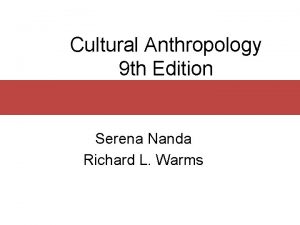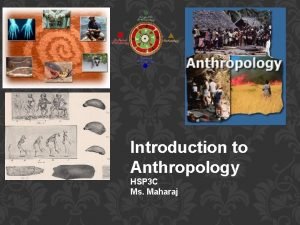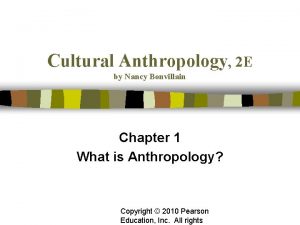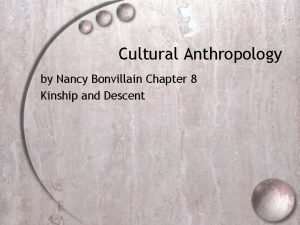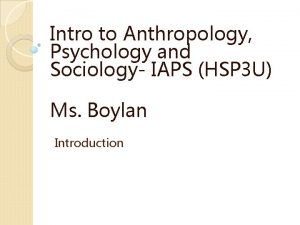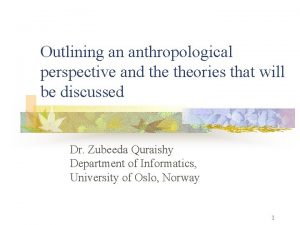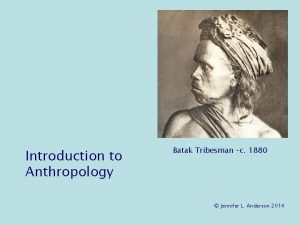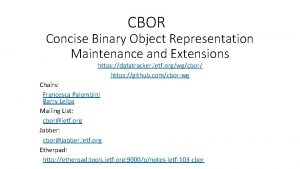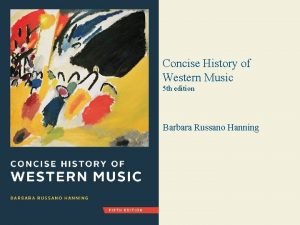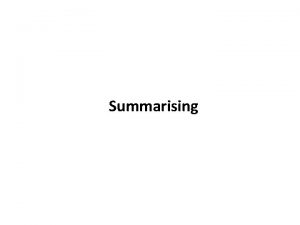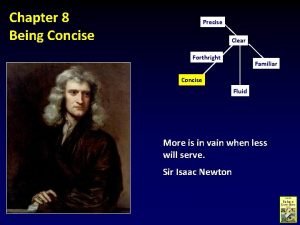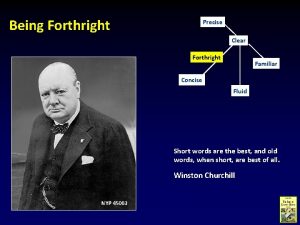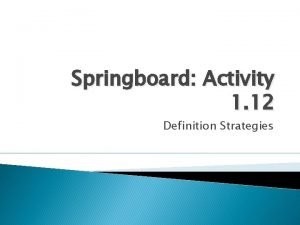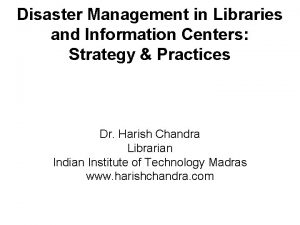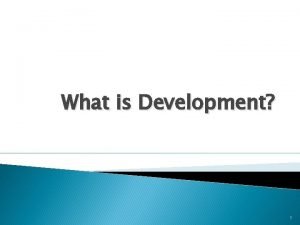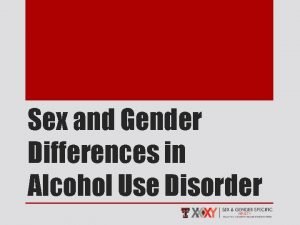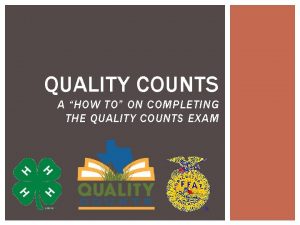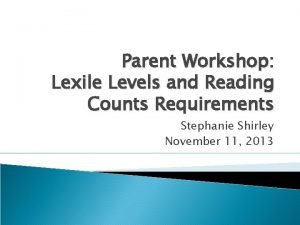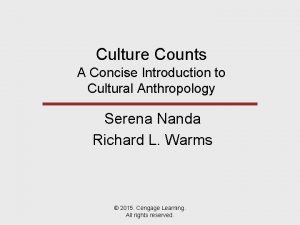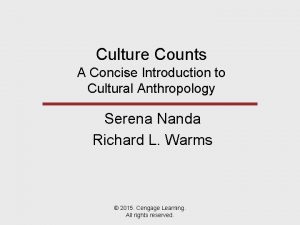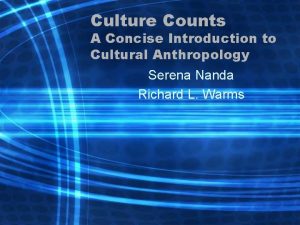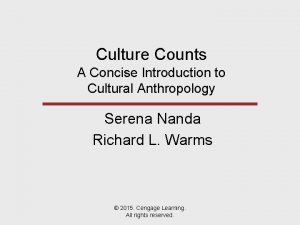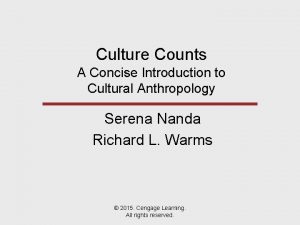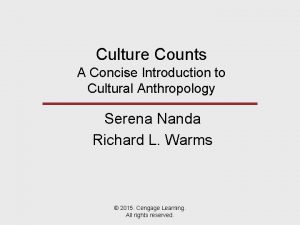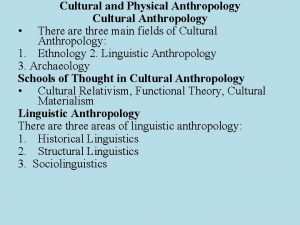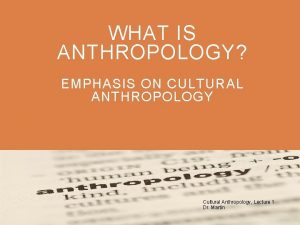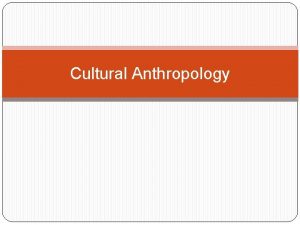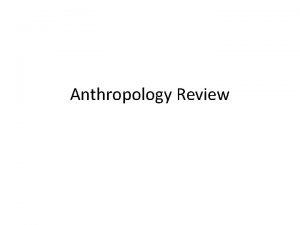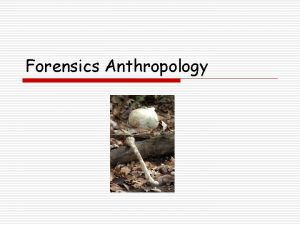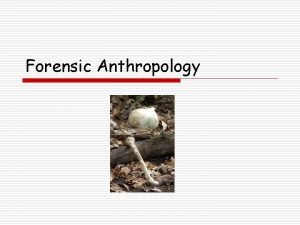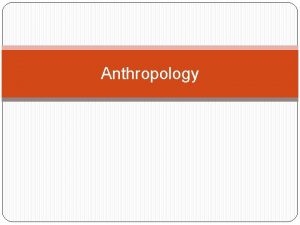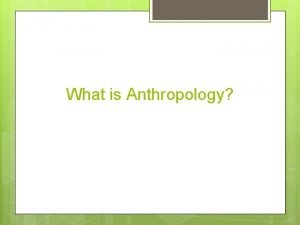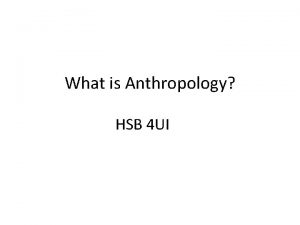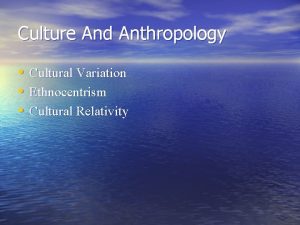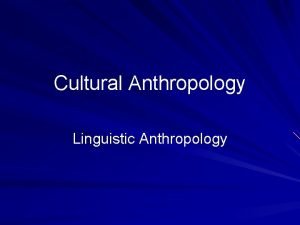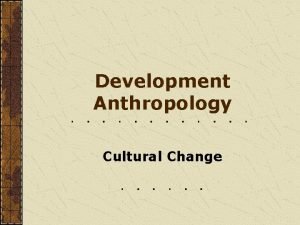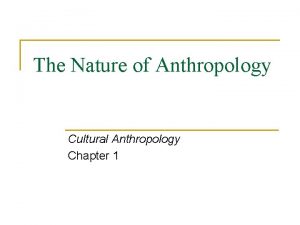Culture Counts A Concise Introduction to Cultural Anthropology


































































- Slides: 66

Culture Counts A Concise Introduction to Cultural Anthropology Serena Nanda Richard L. Warms © 2015. Cengage Learning. All rights reserved.

Chapter 9 Marriage, Family and Kinship © 2015. Cengage Learning. All rights reserved.

Chapter Outline • • • A Society without Marriage: The Na of China Forms and Functions of Marriage Rules The Exchange of Goods and Rights in Marriage Family Structures, Households, and Rules of Residence © 2015. Cengage Learning. All rights reserved.

Chapter Outline • • Kinship Systems: Relations Through Blood and Marriage The Classification of Kin © 2015. Cengage Learning. All rights reserved.

A Society without Marriage: The Na of China • • The Na do not practice marriage, or even have a word for it. In the idealized Na partnership, men pass nights in a lover’s household and return to their families in the morning. All sexual activity takes place during this concealed visit. As lovers, their relationship involves affection, respect, and intimacy, but not fidelity, permanence, or responsibility for children. Concealment is necessary because of a Na taboo forbidding a household’s male members to hear or see any sexual talk or activities involving household females. Both women and men have multiple partners, no records are kept to determine paternity and the Na have no word for incest, illegitimate child, infidelity, or promiscuity. © 2015. Cengage Learning. All rights reserved.

A Society without Marriage: The Na of China • • Matrilineal – children stay with mother’s household their entire lives Males in the household are relatives from different generations (brothers, uncles, grand uncles); there are no husbands or fathers Singular occurrence that entails no future conditions Chinese state has tried to change what they call “barbaric practice” but without success Na visit has been part of Na culture for over a thousand years As Na adapt to new conditions of nation-state and globalization, they frequently are subjected to public schools and media, which stigmatize Na practices This and their inability to name a father on official documents, may spell the end for Na visits © 2015. Cengage Learning. All rights reserved.

Forms and Functions of Marriage • • Marriage - Customs, rules, and obligations that establish a socially endorsed relationship between: • Sexually cohabiting adults • Parents and children • Kin groups of the bride and groom • Links kin groups so more cooperation among groups larger than the married couple Marriage is widespread but not universal, as the Na demonstrate Stable union that involves responsibility for children as well as economic exchange Extends social alliances bc it links different family and kin groups © 2015. Cengage Learning. All rights reserved.

Forms and Functions of Marriage • • Both marriage and family are cultural patterns; thus they differ in function and form among and within different societies. Across cultures there are many types of marriages: • Heterosexual and monogamous (America) • Polygamy • Same sex marriage They differ with changes over time (political or economic practices) and with the life stages of individuals. © 2015. Cengage Learning. All rights reserved.

Forms and Functions of Marriage • • The heterosexual, monogamous marriage dominant in the United States is only one type of marriage. Same sex marriages are now legal in the U. S. Marriages built around plural spouses or samesex relationships also fulfill the functions of marriage. • African societies – women marriages Hard to define “marriage” © 2015. Cengage Learning. All rights reserved.

Forms and Functions of Marriage Family • • Concept of “family” varies among cultures In the United States, the definition of the family is changing to accommodate: • High divorce rates • Same-sex partnerships • Working mothers and single-parent households • Unmarried couples living together • Childless couples • People who never marry • People who remarry © 2015. Cengage Learning. All rights reserved.

Marriage Rules Every society has culturally defined rules concerning sexual relations and marriage. • May limit marriage to certain groups • Determine number of spouses; how many people one can marry • Allows for dissolving marriages • Determines rules for remarriage • Dictate the kinds of exchanges and rituals that legitimate marriage • Determine rights and obligations established by marriage © 2015. Cengage Learning. All rights reserved.

Incest Taboo • • • Prohibits related individuals from having sex with each other; Universal Varies cross culturally The most widespread taboo is mating between nuclear family (mother and son, father and daughter, and sister and brother). Kinship is socially constructed Prohibits marriage among certain kin. © 2015. Cengage Learning. All rights reserved.

Incest Taboo Different theories of possible origin of taboo: • Avoids inbreeding (genetically harmful) • Prevents disruption in the nuclear family • Directs sexual desires outside the family • Forces people to marry outside the family and create a larger social community (alliance theory) © 2015. Cengage Learning. All rights reserved.

Forming Wider Alliances Alliance Theory: • Incest taboo forces people to marry outside a family which leads to joining families into a larger social community • Stressed adaptive value of cooperation among groups larger than nuclear family • Since such alliances are adaptive, the alliance theory can also account for the extension of the incest taboo to groups other than the nuclear family. Exogamy – rule specifying that a person marry outside particular groups © 2015. Cengage Learning. All rights reserved.

Exogamy • a rule specifying that a person must marry outside particular groups • incest taboo is a rule of exogamy related to nuclear family • Exogamy is almost universal within the primary family group • rules of exogamy also extend to wider kinship groups • reduces conflicts over sex • forges alliances between groups larger than the primary family © 2015. Cengage Learning. All rights reserved.

Endogamy ENDOGAMY • Rules that marriage must be within one’s own group (however that group is defined) • Varies cross-culturally • Kept privileges and wealth of a group intact • Amid royalty in ancient Egypt, Peru, or Hawaii brother sister marriage was encouraged as it also limited rivalries for the throne • India – each caste is an endogamous group • U. S. – ethnic/racial groups tend to be endogamous - based on opportunities to meet, cultural norms, and similarities in lifestyle • Amish and other religious groups – endogamy is very important • May include such variables as religion, class, race, and ethnic affiliation © 2015. Cengage Learning. All rights reserved.

Preferential Marriage Rules COUSIN MARRIAGE- Rules about the preferred for cousins to marry each other • Shows that kinship rules are rooted in biological relationships but based on culture • Cross cousins: • The children of a parent’s siblings of the opposite sex • Parallel cousins: • The children of a parent’s same-sex siblings © 2015. Cengage Learning. All rights reserved.

Levirate and Sororate LEVIRATE AND SORORATE - demonstrate importance of marriage as an alliance between two groups; allows marriage to survive death of a partner and still continue group alliances and marriage contract • Levirate: Man marries the widow of a deceased brother • Allows marriage to survive the death of a man • Children stay with the paternal descent group. • Children remain with their mother. • Sororate: When a man’s wife dies, her sister is given to him as wife • Allows marriage to survive the death of a woman • Children are considered part of the paternal descent group. © 2015. Cengage Learning. All rights reserved.

Kinship Diagram of Cousins © 2015. Cengage Learning. All rights reserved.

Number of Spouses • • All societies have rules about how many spouses a person can have at one time. Monogamy (each partner may have only one partner at the same time) is the norm only in Europe and North America. Polygamy (polygyny) (plural marriage) is most common marriage form cross-culturally About 75% of world’s cultures permit polygamy © 2015. Cengage Learning. All rights reserved.

Polygamy • • • Polygamy: A rule allowing more than one spouse Two forms: Polygyny: • A rule permitting a man to have more than one wife at a time Polyandry: • A rule permitting a woman to have more than one husband at a time © 2015. Cengage Learning. All rights reserved.

Polygyny • • Polygyny: Marriage of one man to several women Found in cultures where the man’s status is universally high Found in societies where: • Women are economically important • Women increase man’s wealth and thus, his social position • Extended social alliances are significant Varies cross-culturally • Women’s status can be very high or low • There may or may not be much conflict among co-wives. © 2015. Cengage Learning. All rights reserved.

Polygyny • • • Polygyny is extremely common • Example: Tiwi (Australia) • Foraging group - Women’s gathering food is valuable contribution • The more wives, the higher the standard of living. • Women’s status is high. • Women have a high degree of sexual and economic freedom. Where women’s work is hard and monotonous, as it often is, women may welcome the addition of a co-wife • Eases their workload • Provides daily companionship Frequency of polygyny is decreasing – changing economic conditions, increasing cost of educating children, and social pressure of Western and Christian condemnation of polygyny © 2015. Cengage Learning. All rights reserved.

Polyandry • • Polyandry: Marriage of one woman to several men Relatively rare (Tibet, Nepal, and some indigenous groups) Most is fraternal – brothers marry a single wife Associated with shortage of land (keeps family land within the family and intact) May also be an adaptation to shortage of women Highly functional in societies where men are away from home for long periods of time • Example: Toda (South India) • Related to shortage of women caused by female infanticide • Consists of fraternal polyandry • Sexual access to wife rotates equally • Eldest brother recognizes all children in marriage • The woman has more than one husband to provide for her when other husband is away Changing today as female infanticide has declined © 2015. Cengage Learning. All rights reserved.

Choosing a Mate • • In most societies, marriage is important because it links kin groups of the married couple (kin relations are more important than individual desires) Families take an active role in spouse selection. Very different from marriage in U. S. (people select their own mate) Arranged marriage – when families of the bride and groom select their children’s spouses • Common in many societies, especially India • Economic potential of the groom (and increasingly the bride) is important. • For brides: reproductive potential, health, and physical attractiveness are important © 2015. Cengage Learning. All rights reserved.

Choosing a Mate • • • India – patriarchal, patrilineal, patrilocal Even contemporary women often prefer arranged marriage Now more likely to meet before marriage (traditionally you didn’t see spouse until the day of wedding) Rather than families paying dowries for their daughters, women are saving for their dowries…this has led to greater independence for unmarried women who are demanding more rights to choose their own mate These “love matches” have disrupted the kin support networks that accompany arranged marriages and put these women at greater risk for abuse and infidelity © 2015. Cengage Learning. All rights reserved.

Exchange of Goods in Marriage • Ritual and ceremony surround the transaction of marriage • It involves the transfer of rights and obligations, primarily involving sexual access of the partners. • It involves rights to children born in the marriage • Obligations by one or both of the parents to care for children born into the union. • It involves mutual economic rights among the partners. • Almost universally, marriage requires and exchange of goods or services between the families of the bride and groom • These “gifts” are obligatory for the transfer of marital rights • If the exchanges are not complete, the rights in the marriage can be forfeited. © 2015. Cengage Learning. All rights reserved.

Exchange of Goods in Marriage • Three kinds of exchanges made in connection with arranged marriage: • Bride service • Bridewealth • Dowry © 2015. Cengage Learning. All rights reserved.

Bride Service • • • The husband must work for a specified period of time for his wife’s family in exchange for his marital rights. Occurs mainly in foraging societies, where accumulating material goods for an exchange at marriage is difficult Among the Ju/’hoansi a man may work for his wife’s family for as long as 15 years or until the birth of the third child. © 2015. Cengage Learning. All rights reserved.

Bridewealth • • Cash or goods are given by the GROOM’S FAMILY to the BRIDE’S FAMILY to seal a marriage. The most common form of marriage exchange In these societites, daughters are valuable to their families bc daughter’s bridewealth finances males’ marriages. Bridewealth paid at marriage is returned if a marriage is terminated. Allows husband domestic, economic, sexual, and reproductive rights Allows wives to hold their husbands accountable for violations of conjugal rights Creates a stable marriage by giving BOTH FAMILIES a vested interest in keeping the couple together Kipsigis (East Africa) © 2015. Cengage Learning. All rights reserved.

Dowry • • A presentation of goods by the BRIDE’S KIN to the GROOM’S FAMILY Less common than other forms of exchange at marriage Common in India Belongs to the couple (basic household items for their home) or is supposed to Theories about dowry • It is a voluntary gift given as affection for a daughter. • It is a source of security for the woman. • It is a compensatory payment given by the bride’s family to groom’s family as an acknowledgement of the economic burden of marriage (ideally, women do not work outside of the home) Today, it has become payment to the husband his kin that improves the couple’s financial and social standing (increased consumerism and social class mobility) As such, insufficient dowry can be used to justify emotional blackmail, wife abuse, murder, and has caused abused wives to commit suicide. © 2015. Cengage Learning. All rights reserved.

Family structures, households, and rules of residence Anthropologists identify two basic types of families. 1. The nuclear family is organized around the conjugal tie, the relationship between husband wife. 2. The extended family is based on consanguineal, or blood, relations extending over three or more generations. © 2015. Cengage Learning. All rights reserved.

Family structures, households, and rules of residence • • • Household is not same as family; composition is affected by cultural rules about residence after marriage Household – mostly people related by blood – non-kin may be included Family – members may be spread out over several households © 2015. Cengage Learning. All rights reserved.

Family Structures, households, and rules of residence • • Household composition is affected by cultural rules about residence after marriage Residence Rules: • Neolocal residence – married couples create their own households • Patrilocal residence: The woman lives with the husband’s family • Matrilocal residence: The husband lives with the wife’s family • Avunculocal residence: The newly-married couple lives with the husband’s uncle’s family (mother’s brother) • Bilocal residence: The married couple can choose living with wife’s or husband’s family © 2015. Cengage Learning. All rights reserved.

Nuclear Family • • • Consisting of married couple and their children; associated with neolocal residence Only 5% of the world’s societies (including U. S. ) are traditionally neolocal Adapted to making a living in capitalist society where jobs do not depend on family connections and where employment and promotions often require geographic mobility Associated with independent and flexible societies Found in 75% of the foraging societies in the world © 2015. Cengage Learning. All rights reserved.

The Changing American Family • • • Idealist picture of independent nuclear family is changing Divorce rates rose in the 1960 s; this led to single parent households More single parent working moms, same sex marriage, unmarried couples living together, surrogate reproduction, childless couples, people who never marry, people who remarry, three generation households © 2015. Cengage Learning. All rights reserved.

The changing American family • High rates of divorce and remarriage that blend nuclear families in larger and more complicated kinship networks – “Blended Family” • Although blended families provide the kind of support provided in two-parent families, there are problems: • One child in six averages a weekly visit with a divorced father • One child in four sees dad once a month • Almost half of children of divorce have not seen biological father for more than a year • More than two thirds have lost contact with father ten years later © 2015. Cengage Learning. All rights reserved.

The Changing American Family Number of children born to unmarried mothers is increasing; today it is over 40% • Sweden, France, and UK also have high rates of unmarried mothers • Most unmarried mothers are between 20 -30 • Rates of birth to unmarried mothers has risen in all ethnic groups in U. S. , but are particularly high among Hispanic and African American women • Single mothers are poorer than other families, unless mom is a college graduate © 2015. Cengage Learning. All rights reserved.

Composite Family • • Aggregates of nuclear families linked by a common spouse Typical of polygynous household consisting of one man with several wives; wives occupy different residences Tie between mother and children is very strong Dynamics are complicated (husband, wives, cowives, children) © 2015. Cengage Learning. All rights reserved.

Extended Family • • Blood relations extending over two or more generations Blood ties between generations (like father and son) are more important than marriage ties Advantage for cultivators: provides more workers so more food and handicrafts Economic advantages: Keeps land intact and provides security in times of crisis There are two types of extended families. Patrilineal extended families • Organized around the male line • Tends to be accompanied by patrilocal residence Matrilineal extended families • Organized around the female line • Tends to be accompanied by matrilocal residence © 2015. Cengage Learning. All rights reserved.

Using Anthropology – Families adapting to Globalization • • • Residence rules and family type are economically and politically adaptive. Patrilocality - functional in traditional hunting and agricultural societies where men work cooperatively or where males cooperate in warfare New economies, along with population increase, the spread of global capitalism, changing technology, and women’s new economic roles have greatly affected family patterns © 2015. Cengage Learning. All rights reserved.

Using Anthropology – Families adapting to Globalization • • As more women enter workforce, value of marriage has declined Many marrying later or remaining single Childbearing is decreasing Children are good economic investment in agricultural and herding societies; cost of raising them is low and they provide economic boost; but these subsistence patterns are decreasing Urban settings based on and information and service economy - economic benefits go to those with training. In U. S. cost of raising a child for middle income family is about $300. 000 (birth to 18) Cost of raising children is high, economic benefit is low In poor nations, costs are lower but in urban areas, cost is high and this has reduced family size dramatically (Ethiopia – families in city have approx. four fewer children than those in rural areas) © 2015. Cengage Learning. All rights reserved.

Using Anthropology – Families adapting to Globalization • • • Government policies and technology also affect family size China has had one child policy until recently China and India viewed male children as more prestigious than females Combine that with policies promoting family planning, high cost of rearing child, ultrasound technology has allowed people to see the sex of their child, which has resulted in more boys than girls being born (strengthened by infanticide, abortion, and neglect of girls Has led to a lack of marriage partners for men The holistic approach of anthropology highlights the interconnectedness between political, economic, technological, and cultural factors in analyzing globalization and cultural change © 2015. Cengage Learning. All rights reserved.

Kinship Systems: Relationships through Blood and Marriage • • Kinship – a culturally defined relationship established on the basis of blood ties or through marriage Determines the formation of social groups (like families) Is the basis for classification of people in relation to each other Structures individual rights and obligations Regulates behavior All these elements are intertwined so anthropologists refer to kinship as a system Kinship systems: The totality of kin relations, kin groups, and terms for classifying kin in a society; elements of social life and kinship are intertwined ; rests on biological relationships but are a cultural phenomenon © 2015. Cengage Learning. All rights reserved.

Kinship • Kinship is the most important social bond in small-scale, nonindustrial societies. • Determines the formation of social groups and is the basis for classification of people in relation to one another. • It governs the most important relationships, rights, and responsibilities. • It is the main way of linking groups to one another and incorporating strangers into a group. • It is the structure for inheritance. • It creates a sentimental association. • Important on many ritual occasions • Strong sentiment that “blood is thicker than water” © 2015. Cengage Learning. All rights reserved.

Functions of Kinship • • Provides continuity between generations Provides for orderly transmission of property (inheritance) or social position (succession) Defines a group on whom a person can rely for aid Very adaptive to have social group larger than nuclear family which is why expanded kin groups are found in so many societies © 2015. Cengage Learning. All rights reserved.

Rules of Descent and the Formation of Descent Rules • • • Descent - Culturally established affiliation between a child and one or both parents Descent Groups – group of blood kin who are descendants of a common ancestor, extending beyond two generations Functions (in non-industrial countries) • Organize domestic life • Enculturate children • Allow transfer of property • Carry out religious ritual • Settle disputes • Engage in warfare • Structure the use of political power © 2015. Cengage Learning. All rights reserved.

Unilineal Descent – descent based on links through paternal or maternal line, but not both • Advantages: • Forms non-overlapping descent groups that develop close bonds between members • Perpetuate themselves over time even though membership changes • Provides clear group membership for everyone in the society • understand rights of ownership, social duties, and social roles Bilateral descent – membership based on links through both maternal and paternal line © 2015. Cengage Learning. All rights reserved.

Types of Unilineal Descent Groups • • • Lineage - group of kin whose members trace descent from a known common ancestor Two types of lineages • Patrilineage – lineage formed through descent through the male line • Matrilineage – formed by descent through female line Related lineages may form a clan • Clan - Unilineal kinship group whose members believe they are descended from a common ancestor but who can’t trace the link through known relatives; exogamous groups • Common clan ancestor may be a mythological figure or no specific ancestor is known or named • Clans have different functions in different groups • Political, religious, marriage © 2015. Cengage Learning. All rights reserved.

Patrilineal Descent Groups • • Descent, for both males and females, is traced through male lineage. Status can vary, but women frequently have relatively low status Inheritance moves from father to son, as does succession to office. Usually patrilocal residence – can be isolating to wife bc none are her kin Man’s position as father and husband is the most important source of male authority. Husband guaranteed rights and control over wife and children (maintains descent group) Example: Nuer of Sudan • Pastoral people • Patrilineal membership confers rights to land, requires participation in certain religious ceremonies, and determines political and judicial obligations (like making alliances in feuds and warfare) • Lineage membership spreads over several villages, creating many alliances • Believe close kin should not fight with one another, so disputes within the lineage or clan tend to be kept small and settled quickly • Participate in warfare © 2015. Cengage Learning. All rights reserved.

Kinship Diagram of Patrilineal Descent • Sons and daughters belong to their father’s descent group (shown in dark green), as do the children of sons — but not of daughters. © 2015. Cengage Learning. All rights reserved.

Matrilineal Descent Groups • • • Children belong to the mother’s descent group. Most important ties are between woman, her mother, and her siblings Women usually have higher status. Inheritance and succession move from mother to daughter Matrilocal residence The inclusion of a husband in the household is less important so marriages are less stable © 2015. Cengage Learning. All rights reserved.

Matrilineal Descent Groups • • • Rights and responsibilities of father fall to the woman’s brother rather than her husband Husband’s loyalty is split between his own sons and the sons of his sister • May lessen conflict between fathers and sons, but father is committed to pass on his knowledge, property, and offices to his sister’s sons • May create conflict with nephews, who are subject to his control Thus, a man’s loyalty is split between his own sons and the sons of his sister (this does not happen in patrilineal system). © 2015. Cengage Learning. All rights reserved.

The Hopi (U. S. Southwest) • Matrilineal Pueblo group • Mother daughter relationship very close • Based on blood ties, common activities, and lifelong residence together • Mother is responsible for economic and ritual training of daughters • After marriage, daughters usually live with their mother and their mother’s sisters • Tie between sisters is very strong, whose relationship to mother is the foundation of the household • Hopi men consider their mother’s place as home (they are of her lineage), to which they return for many ritual and ceremonial occasions, or upon separation or divorce • In matrilineal societies, a Hopi man has authority and control over his sister’s sons and transmits ritual and heritage • Boy’s relationship with maternal uncle is characterized by respect, reserve, and even fear; relationship with father is affectionate and involves little discipline • Hopi man teaches sons main tasks of farming and sheepherding, and sons support their father in his old age. • Hopi man has affectionate but not close relationship with daughter; has few specific duties in her upbringing © 2015. Cengage Learning. All rights reserved.

Kinship Diagram of Matrilineal Descent • Sons and daughters are members of their mother’s descent group (shown in dark green), as are the children of daughters — but not of sons. © 2015. Cengage Learning. All rights reserved.

Bilateral Kinship Systems • • • Non-unilineal Kinship: Bilateral or Ambilineal Bilateral • System under which both maternal and paternal lines are used in reckoning descent and establishing the rights and obligations of kinship • Do not have clear cut descent groups; instead have network of kin called a kindred • KINDRED – defined only in its relation to a particular individual; overlapping groups of kin, rather than social groups, so more difficult to organize Ambilineal • A form of bilateral descent in which an individual may choose to affiliate with either the father’s or mother's descent group © 2015. Cengage Learning. All rights reserved.

The Classification of Kin • • The system of kinship terms and the rules for using these terms One of the most important regulators of behavior in societies Every kinship classification system classes some relatives together and differentiates them from other relatives. Although people in every society consider their own kinship system natural and normal, the logic underlying all kinship systems is cultural, not biological © 2015. Cengage Learning. All rights reserved.

Quick Quiz © 2015. Cengage Learning. All rights reserved.

1. Explanations for the function of incest taboos include all EXCEPT which of the following? a) It forces people to make alliances with other families, expanding societal links. b) Taboos prohibiting mating between closely-related individuals arose because of the higher incidence of deleterious traits. c) Incest taboos restrict damaging consequences of inbreeding. © 2015. Cengage Learning. All rights reserved.

Answer: b • Explanations regarding the function of familial incest taboos don’t include the following: • Taboos prohibiting mating between closely-related individuals arose because of the higher incidence of deleterious traits. © 2015. Cengage Learning. All rights reserved.

2. A young husband has an unfortunate encounter with a crocodile as he is herding his cows along the banks of the Nile River. As custom dictates, his brother marries the bereaved widow, adding her to his polygynous household. This is an example of: a) the sororate. b) the practice of bride-service. c) the levirate. d) an arranged marriage. © 2015. Cengage Learning. All rights reserved.

Answer: c • A young husband has an unfortunate encounter with a crocodile as he is herding his cows along the banks of the Nile River. As custom dictates, his brother subsequently marries the bereaved widow, adding her to his polygynous household. This is an example of the levirate. © 2015. Cengage Learning. All rights reserved.

3. In the United States and in many foraging cultures, we primarily practice _____ descent. a) patrilineal b) bilateral c) matrilineal d) ambilineal © 2015. Cengage Learning. All rights reserved.

Answer: b • In the United States and in many foraging cultures, we primarily practice bilateral descent. © 2015. Cengage Learning. All rights reserved.

4. Which statement best summarizes anthropological thinking on the functions of dowry? a) The dowry is a woman's wealth to keep as her own economic security. b) Dowry is compensation from the groom's family since the bride will not inherit from her family. c) In societies that practice the dowry, it is part of the process of legitimization of the new alliance formed by a marriage. © 2015. Cengage Learning. All rights reserved.

Answer: c • The following statement best summarizes anthropological thinking on the functions of dowry across the societies in which this custom is practiced: • In societies that practice the dowry, it is part of the process of legitimization of the new alliance formed by a marriage. © 2015. Cengage Learning. All rights reserved.
 Introducing phonology answer key
Introducing phonology answer key Cultural anthropology examples
Cultural anthropology examples Hsp3c
Hsp3c Bonvillain clothing
Bonvillain clothing Cultural anthropology nancy bonvillain
Cultural anthropology nancy bonvillain What is anth
What is anth Sociocultural system
Sociocultural system Anthropology psychology and sociology
Anthropology psychology and sociology Anthropology psychology and sociology venn diagram
Anthropology psychology and sociology venn diagram What is anthropology
What is anthropology Anthropological perspective example
Anthropological perspective example Introduction to anthropology
Introduction to anthropology Comprehensive yet concise
Comprehensive yet concise Pretentious diction example
Pretentious diction example Concise binary object representation
Concise binary object representation Concise writing style
Concise writing style Concise history of western music 5th edition
Concise history of western music 5th edition Concise thesis statement
Concise thesis statement Short but concise
Short but concise Objective and concise
Objective and concise Being concise
Being concise Precise vs concise
Precise vs concise Vigorous sentence
Vigorous sentence Concise definition
Concise definition A clear concise document which outlines preventive
A clear concise document which outlines preventive Relatively orderly
Relatively orderly Vigorous writing
Vigorous writing Concise precise
Concise precise Concise style
Concise style Example of pop culture
Example of pop culture Individual culture traits combine to form culture patterns.
Individual culture traits combine to form culture patterns. Batch culture vs continuous culture
Batch culture vs continuous culture Fed-batch
Fed-batch Individualistic culture vs. collectivist culture
Individualistic culture vs. collectivist culture American culture vs indian culture
American culture vs indian culture Stab and stroke culture
Stab and stroke culture Folk culture and popular culture venn diagram
Folk culture and popular culture venn diagram Sub culture group
Sub culture group Leisure
Leisure Anaerobic media
Anaerobic media Folk culture and popular culture venn diagram
Folk culture and popular culture venn diagram In an inert organizational culture,
In an inert organizational culture, Anaerobic culture method
Anaerobic culture method Carpet culture method
Carpet culture method Characteristics of quality culture
Characteristics of quality culture Surface culture deep culture and esol
Surface culture deep culture and esol Steve ward calm counts
Steve ward calm counts Tdot traffic count
Tdot traffic count Cage questionnaire
Cage questionnaire It consists of numbers representing counts or measurements.
It consists of numbers representing counts or measurements. Quality counts background checks
Quality counts background checks Will counts
Will counts College and career readiness lexile chart
College and career readiness lexile chart Bias by photos captions and camera angles definition
Bias by photos captions and camera angles definition Make every opportunity count
Make every opportunity count Every opportunity counts
Every opportunity counts Bias by photos captions and camera angles
Bias by photos captions and camera angles Glasgow counts framework
Glasgow counts framework What counts as a significant figure
What counts as a significant figure Math counts books
Math counts books Semcog traffic counts
Semcog traffic counts Daily depositor calendar math
Daily depositor calendar math Character counts citizenship
Character counts citizenship Skip counting on number line
Skip counting on number line Bias through selection and omission
Bias through selection and omission Trrfcc character counts
Trrfcc character counts Fdot psee
Fdot psee

